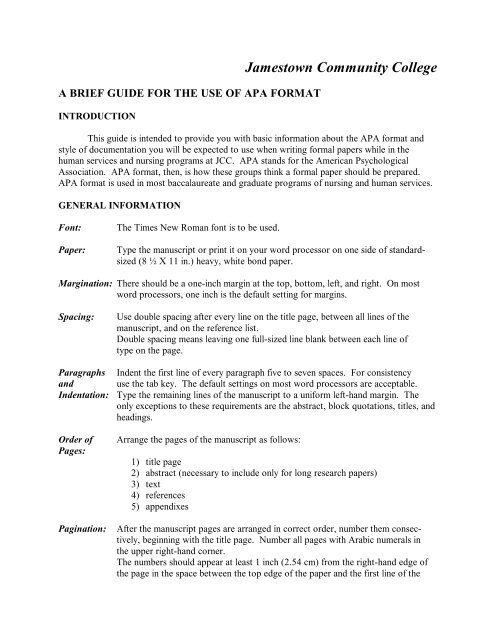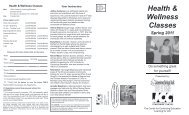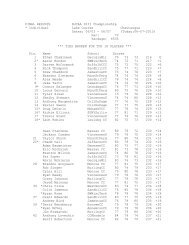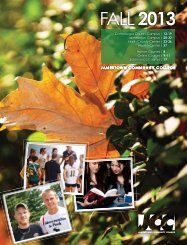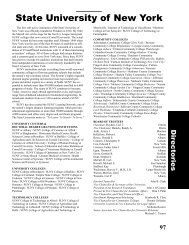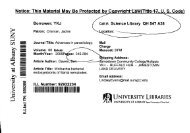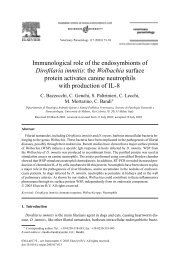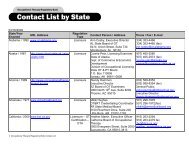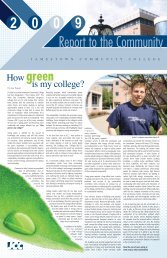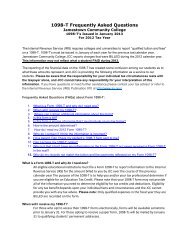APA Style Guide - Jamestown Community College
APA Style Guide - Jamestown Community College
APA Style Guide - Jamestown Community College
You also want an ePaper? Increase the reach of your titles
YUMPU automatically turns print PDFs into web optimized ePapers that Google loves.
A BRIEF GUIDE FOR THE USE OF <strong>APA</strong> FORMAT<br />
INTRODUCTION<br />
<strong>Jamestown</strong> <strong>Community</strong> <strong>College</strong><br />
This guide is intended to provide you with basic information about the <strong>APA</strong> format and<br />
style of documentation you will be expected to use when writing formal papers while in the<br />
human services and nursing programs at JCC. <strong>APA</strong> stands for the American Psychological<br />
Association. <strong>APA</strong> format, then, is how these groups think a formal paper should be prepared.<br />
<strong>APA</strong> format is used in most baccalaureate and graduate programs of nursing and human services.<br />
GENERAL INFORMATION<br />
Font:<br />
Paper:<br />
The Times New Roman font is to be used.<br />
Type the manuscript or print it on your word processor on one side of standardsized<br />
(8 ½ X 11 in.) heavy, white bond paper.<br />
Margination: There should be a one-inch margin at the top, bottom, left, and right. On most<br />
word processors, one inch is the default setting for margins.<br />
Spacing:<br />
Use double spacing after every line on the title page, between all lines of the<br />
manuscript, and on the reference list.<br />
Double spacing means leaving one full-sized line blank between each line of<br />
type on the page.<br />
Paragraphs Indent the first line of every paragraph five to seven spaces. For consistency<br />
and use the tab key. The default settings on most word processors are acceptable.<br />
Indentation: Type the remaining lines of the manuscript to a uniform left-hand margin. The<br />
only exceptions to these requirements are the abstract, block quotations, titles, and<br />
headings.<br />
Order of<br />
Pages:<br />
Pagination:<br />
Arrange the pages of the manuscript as follows:<br />
1) title page<br />
2) abstract (necessary to include only for long research papers)<br />
3) text<br />
4) references<br />
5) appendixes<br />
After the manuscript pages are arranged in correct order, number them consectively,<br />
beginning with the title page. Number all pages with Arabic numerals in<br />
the upper right-hand corner.<br />
The numbers should appear at least 1 inch (2.54 cm) from the right-hand edge of<br />
the page in the space between the top edge of the paper and the first line of the
text.<br />
Page Headers: Identify each manuscript page (including the title page) with the first two or<br />
three words from the title in the upper right-hand corner above or five spaces<br />
to the left of the page number.<br />
Punctuation: There is only one space after any period, whether it is in the reference list or in<br />
the text. There is no need for two spaces after periods.<br />
TITLE PAGE<br />
• The title should indicate the main idea of the paper.<br />
• Type the title in upper and lower case letters and center it on the page. If the title is two<br />
or more lines, double space between the lines.<br />
• Type your first name, middle initial, and surname one double space below the title.<br />
• Type the name of the college one double space below your name.<br />
Note: A running head is included only when the paper is to be published.<br />
Example of Title Page:<br />
Formatting Differences 1<br />
Presentation of Major Formatting Differences<br />
Found Within the <strong>APA</strong> <strong>Style</strong> of Writing<br />
John B. Doe<br />
The University of Central Arkansas<br />
2
CITATION OF REFERENCES WITHIN THE TEXT<br />
The citations that appear throughout the body of the paper are necessary because they<br />
give credit to the original author. Both direct quotes and paraphrasing require citation. Citations<br />
include the author’s last name and the year of publication. For quoted material, a page number is<br />
also included.<br />
Citations When Paraphrasing:<br />
One Author<br />
Include last name of author and the year of publication.<br />
According to Jones (2001), the age. . . .<br />
Recent research (Jones, 2001) indicates. . . .<br />
Two Authors<br />
Include last names of both authors.<br />
LeMone and Burke (1996) consolidated data. . . .<br />
Statistics indicate (LeMone & Burke, 1996). . . .<br />
Note on using “and” and “&”:<br />
Use the ampersand (&) within the parentheses and in the reference list.<br />
(LeMone & Burke, 1996)<br />
Spell out the word “and” within the text.<br />
LeMone and Burke (1996) reviewed. . . .<br />
Three to Five Authors<br />
At first mention, cite all last names. On second and subsequent mentions, include the name of<br />
the first author only.<br />
Kozier, Erb, Berman and Burke (2001) found that. . . .<br />
According to Kozier (2001),<br />
3
Citations When Paraphrasing, continued:<br />
Six or More Authors<br />
Cite only the surname of the first author followed by et al. (include a period after al., but do not<br />
underline) and the year for the first and subsequent citations.<br />
Moran et al. (1997) pointed out. . . .<br />
Group as Author<br />
The names of groups that serve as authors (e.g., corporations, associations, government agencies)<br />
are usually spelled out each time they appear in a text citation. However, if the name is long and<br />
cumbersome and if the abbreviation is familiar or readily understandable, you may abbreviate the<br />
name in second and subsequent citations.<br />
First text citations: (National Institutes of Mental Health [NIMH], 1998)<br />
Subsequent text citations: (NIMH, 1998)<br />
Anonymous Author<br />
Cite in the text the word “Anonymous” followed by a comma and the date.<br />
(Anonymous, 1993)<br />
Works with No Author: Cite in the text the first few words of the reference entry (usually the<br />
title) and the year. Use double quotation marks around the title of an article or chapter, and<br />
italicize the title of a periodical, book, brochure, or report.<br />
on free care (“Study Finds,” 1992)<br />
the book <strong>College</strong> Bound Seniors (1979)<br />
Citations For Direct Quotations:<br />
Short Quote (less than 40 words)<br />
When using a direct quotation, state the last name of the author or authors, the year of<br />
publication, and the exact page where you found the quote:<br />
Pillitteri pointed out that “hemophilia is caused by deficiency of the<br />
coagulation component factor VIII” (1995, p. 1366).<br />
Note: The year is preceded by a parenthesis, followed by a comma, the letter p is followed by a<br />
period, then the closing parenthesis and, lastly, a period ends the entire sentence. (There is no<br />
period after the quotation marks after VIII.)<br />
4
Quotation of 40 or more words<br />
If your quotation has 40 or more words, you must use a block form. The quote<br />
is indented five spaces and does not have any quotation marks.<br />
Pillitteri (1995) explained that:<br />
In the United States, the incidence is approximately 1 in 10,000<br />
white males. The female carrier may have a slightly lowered but<br />
sufficient levels of the factor VIII component so that she does not<br />
manifest a bleeding disorder. Males with the disease also have<br />
varying levels of factor VIII, and their bleeding tendency varies<br />
accordingly, from mild to severe. (p. 1366)<br />
Note: The page reference comes after the quote, after the period that ends the sentence in the<br />
quote; it is in parentheses, and there is not a period after 1366.<br />
THE REFERENCE PAGE<br />
References are the sources from which you obtained information that is included within<br />
the text. References cited in the text of the paper MUST appear in the reference list with the<br />
exception of personal communications (see p. 214 of the <strong>APA</strong> manual). Each entry in the<br />
reference list should provide the information necessary to identify and retrieve each source.<br />
Page The page header should appear at the top right hand corner of the page as it does on the<br />
Header: title page and in the pages of the text.<br />
The The title informs the reader that this is the reference page. The word References should<br />
Title: be centered at the top of the page and typed in the normal font with no bold, underline, or<br />
quotation marks.<br />
EXAMPLE<br />
References<br />
Formatting Differences 4<br />
5
Abbreviations used in reference entries:<br />
chap. Chapter<br />
ed. Edition<br />
Rev. ed. Revised edition<br />
2 nd ed. Second edition<br />
Ed. (Eds.) Editor (Editors)<br />
p. (pp.) page (pages)<br />
Listing of Reference Entries<br />
• Entries should be arranged in alphabetical order by authors’ last names (surnames).<br />
• Write out the last name (surname) and initials for all authors of a particular work.<br />
• Capitalize only the first word of a title or subtitle, and any proper names that<br />
• are parts of a title.<br />
• Use an ampersand [&] instead of the word “and” when listing multiple authors of a single<br />
work.<br />
• Use the abbreviation p. or pp. to designate page numbers of articles from periodicals that<br />
do not use volume numbers, especially newspapers. These abbreviations are also used to<br />
designate pages in encyclopedia articles and chapters from edited books.<br />
• Indentation: The first line of the entry is flush with the left margin, and all subsequent<br />
lines are indented (5 to 7 spaces) to form a “hanging indent.”<br />
• Underlining vs. Italics: It is appropriate to use italics instead of underlining for titles of<br />
books and journals.<br />
BOOKS<br />
Note: The <strong>APA</strong> has special formatting standards for the use of indentation and italics in<br />
manuscripts or papers that will be submitted for official publication. For more detailed<br />
information on these publication standards, refer to the <strong>APA</strong> publication manual, or<br />
consult with the editors for their style preference.<br />
References to an entire book must include the following elements: author(s) or<br />
editor(s), date of publication, title, place of publication, and the name of the publisher.<br />
No Author<br />
or Editor :<br />
Editor<br />
No<br />
Author:<br />
Peterson’s annual guide to graduate study (33 rd ed.). (1999). Princeton, NJ:<br />
Peterson’s <strong>Guide</strong>s.<br />
Note: The title is placed in the author position.<br />
Sadie, S. (Ed.). (1980). The new Grove dictionary of music and musicians<br />
(6 th ed., Vols. 1-20). London: Macmillan.<br />
Note: The second line is indented using the tab default setting.<br />
6
One<br />
Author:<br />
Two<br />
or more<br />
authors:<br />
Pillitteri, A. (1995). Maternal and child health nursing: Care of the childbearing<br />
and childrearing family (2 nd ed.). Philadelphia: J.B. Lippincott.<br />
Note: If city is well known, the state is not included.<br />
Boumil, M. M., & Friedman, J. (1996). Deadbeat dads: A national child support<br />
scandal. Westport, CT: Praeger.<br />
Note: Include all authors and insert an ampersand before the last author.<br />
PERIODICAL ARTICLES<br />
References to periodical articles must include the following elements: author(s), date of<br />
publication, article title and journal title, volume number, issue number, and page numbers. Title<br />
of the journal and volume number are italicized with the comma following. If pagination starts<br />
over with each issue, include an issue number in parentheses immediately following the volume<br />
number. The issue number is not italicized. For example: RN. 12 (6), 21-23. There is no<br />
comma between the volume and the issue number.<br />
One Masci, D. (2001). Children and divorce. CQ Researcher, 11, 25-39.<br />
Author: Note: Issue number is not necessary as CQ Researcher is paged continuously.<br />
Two Gilboa-Schechtman, E. & Foa, E. B. (2001). Patterns of recovery from trauma:<br />
Authors: The use of intraindividual analysis. Journal of Abnormal Psychology, 110,<br />
392-400.<br />
Note: Capitalize only the first word of the title and of the subtitle, if any, and<br />
any proper nouns, ending with a period – just like writing a sentence.<br />
Three Weibelhaus, P., Hansen, S., & Hill, H. (2001). Helping patients survive inhalation<br />
To Five injuries. RN, 64(10), 28-32.<br />
Authors: Note: Issue number is provided as RN is paginated by issue.<br />
NEWSPAPER ARTICLES<br />
No Study ties self-delusion to successful marriages. (1997, January 2).<br />
Author:<br />
New York Times, p. B-10.<br />
Note: Include section as well as page number.<br />
One Author,<br />
Discontinuous Wingfield, N. (1998, June 18). Unraveling the mysteries inside web<br />
Pages: shoppers’ minds. Wall Street Journal, pp. B6, B9.<br />
Note: If there is no volume number, then you must put a “p” for one page<br />
and a “pp” for more than one page.<br />
7
BROCHURE<br />
The Writing Center of Capital <strong>Community</strong>-Technical <strong>College</strong>. (1997).<br />
Writing: The goal is variety (4 th ed.) [Brochure]. Hartford, CT: Author.<br />
Note: The company that published the brochure is also the author (because their<br />
employees wrote the brochure). “Brochure” is in brackets after the title and edition.<br />
Where you would usually find the publisher after the address, “Author” is written<br />
because the publisher is considered the author.<br />
GOVERNMENT REPORT<br />
References to a report must include the following elements: author(s), date of<br />
publication, title, place of publication, and name of publisher. If the issuing organization<br />
assigned a number (e.g., report number, contract number, or monograph number) to the report,<br />
give that number in parentheses immediately after the title. Do not use period between title and<br />
material in parentheses. Do not italicize parenthetical material.<br />
Wetherington, C. L. & Roman, A. B. (Eds.). (1998). Drug addiction research study (NIH<br />
Publication No. 98-4290). Rockville, MD: National Institutes of Health.<br />
Note: For materials with two or more authors or editors, include all authors or editors, separated<br />
by a comma, and insert an ampersand “&” before the last author.<br />
ELECTRONIC MEDIA<br />
For Internet sources, observe the following guidelines:<br />
1) Provide the author(s) of the document, if available.<br />
2) Provide date of publication or update whenever possible.<br />
3) Provide document title or description.<br />
4) Provide retrieval information.<br />
a. Provide date of retrieval.<br />
b. Provide name of the database or the address of the source.<br />
i. For library (aggregated) databases, the name of the database is sufficient.<br />
ii. For all other web resources, provide the URL (Uniform Resource Locator) for<br />
the specific document rather than home or menu pages. MAKE SURE THE<br />
URL WORKS!!!<br />
5) When providing a URL, NO punctuation should end your reference. Otherwise end<br />
reference with a period.<br />
For examples, see next page.<br />
8
ELECTRONIC MEDIA, continued - Examples:<br />
Electronic copy of an article retrieved from library database (aggregated database).<br />
Note: You begin just as you would for an article with the author, date, and article title. Title of<br />
journal, volume number, and pagination follow. Then use this basic retrieval statement<br />
for databases accessed via the Web:<br />
Retrieved [month day, year], from the [name of database] database.<br />
Anonymous. (1999, November). Can one substance treat both osteoarthritis and depression?<br />
Tufts University Health & Nutrition Letter, 17, 3. Retrieved December 15, 1999, from<br />
the ProQuest database.<br />
Colchico, K., Zybert, P. & Basch, C. E. (2000). Effects of after-school physical activity on<br />
fitness, fatness, and cognitive self-perceptions: A pilot study among urban, minority<br />
adolescent girls. American Journal of Public Health, 90, 977-978. Retrieved October 17,<br />
2001, from ProQuest database.<br />
Fackelmann, K. (1998). Do high heels boost arthritis risk? Science News, 153, 382. Retrieved<br />
December 10, 1999, from the Health Reference Center-Academic database.<br />
Kerrigan, D.C., Todd, M.K., & Riley, P.O. (1998). Knee osteoarthritis and high-heeled shoes.<br />
The Lancet, 351, 1399-1401. Retrieved October 29, 1999, from the Expanded Academic<br />
ASAP database.<br />
Larkin, M. (1999). Juvenile arthritis helped by resistance exercise. Lancet, 354, 1797. Retrieved<br />
December 14, 1999, from the Lexis-Nexis Academic Universe database.<br />
No author identified, section of an Internet resource.<br />
Tretinoin. (2001). In the Drug Database of Nurse’s PDR Resource Center. Retrieved October<br />
17, 2001, from http://nursespdr.com/members/database/ndrhtml/tretinoin.html<br />
U.S. Government report available on government agency web site, agency as author.<br />
U.S. Centers for Disease Control and Prevention. (2000, April). Epidemic/epizootic West Nile<br />
virus in the United States: Revised guidelines for surveillance, prevention, and control.<br />
Retrieved October 17, 2001, from http://www.cdc.gov/ncidod/dvbid/westnile/resources/<br />
wnv-guidelines-apr-2001.pdf<br />
9
FOR FURTHER INFORMATION, you may consult the following sources:<br />
American Psychological Association. (2001). Publication manual of the American<br />
Psychological Association (5th ed.). Washington, DC: Author.<br />
American Psychological Association. (n.d.). <strong>APA</strong><strong>Style</strong>.org. Retrieved October 16, 2001, from<br />
http://www/apastyle.org/elecref.html<br />
<strong>Jamestown</strong> <strong>Community</strong> <strong>College</strong>. (2001). Citing material from library databases – <strong>APA</strong> style.<br />
[Brochure]. Olean, NY: Author. Available in the tutoring center and the library at the<br />
Cattaraugus County Campus.<br />
Rev 10/23/01<br />
MJ & DS<br />
10


